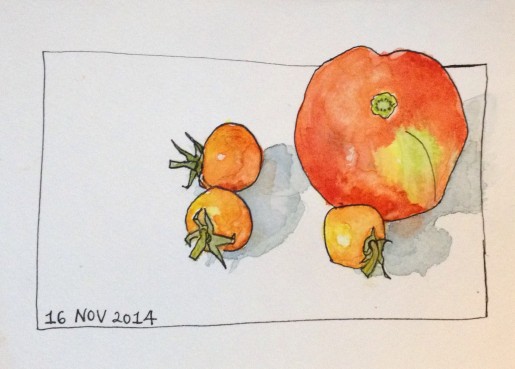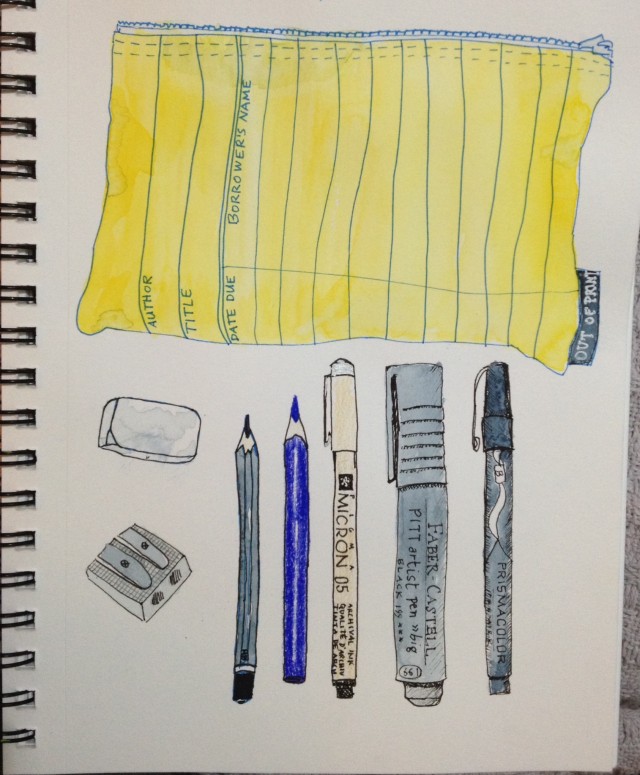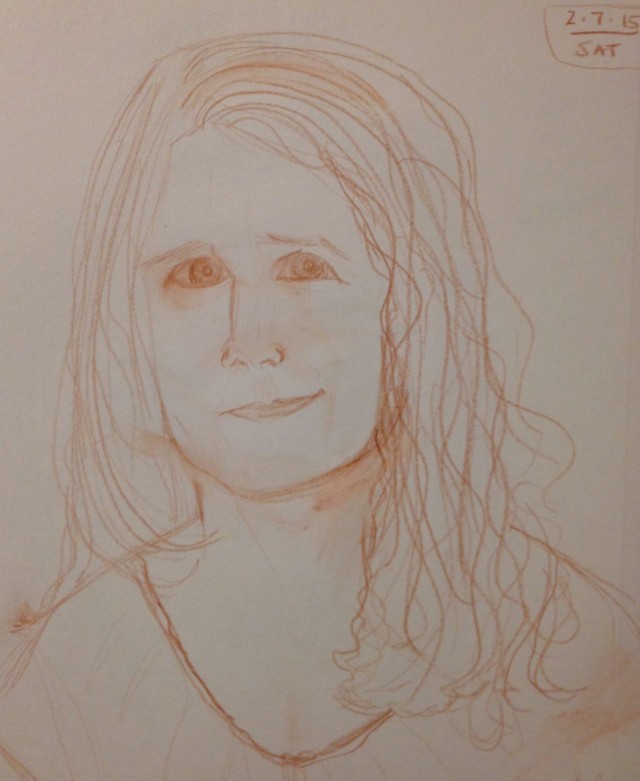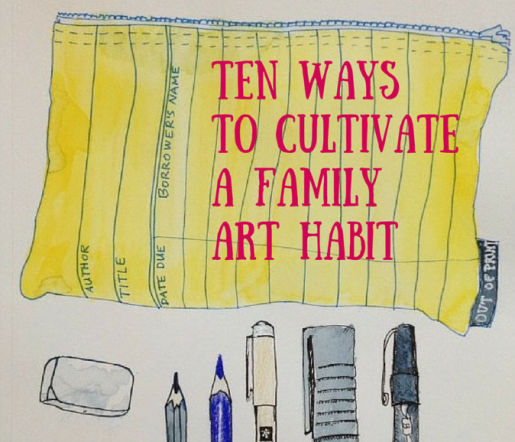Ten Ways to Cultivate a Family Art Habit
On Twitter, Kim asked if I had any advice for a family getting started with sketching and art journaling. Did I ever!
I’ve Storified the conversation, if you’d like to see how it unfolded, but I’ll recap it here as well.
@melissawiley we are a family just starting to open the door to sketching and art journals. any suggestions? thanks. pic.twitter.com/pBRyl9cMgD
— Kim (@ttfhim) February 17, 2015
My replies below, expanded a bit. Points #6 and 7 are the most important.

Suggestions? Yes, lots!
1) Koosje Koene’s Draw Tip Tuesday videos. She also offers classes in drawing and art journaling. (Here’s a post I wrote about her videos in November.)
2) Sign up for a free two-week trial at Creativebug and take Dawn Devries Sokol’s Art Journaling class and Lisa Congdon’s Basic Line Drawing. I wrote about how much Lisa’s class inspired me in my “Learning in Public” post.
3) A bunch of books to inspire you: Lynda Barry’s wonderful Syllabus; Danny Gregory’s new Art Before Breakfast (it’s a delight; I’ll be reviewing it soon) and the much-beloved The Creative License; the Illustration School series; the “20 Ways to Draw a…” series; Claire Walker Leslie’s Keeping a Nature Journal; the Usborne “I Can Draw” series. And a few more recommendations in this older post.
4) Maybe try a Sketchbook Skool course! They offer a free sample class (I mean klass) so you can get a taste of the magic.
5) Cathy Johnson videos. Rilla loves Cathy’s art and her gentle delivery.
6) The most important thing! Really just dive in and do it—if you do it, the kids will follow. Mine truly love to see me working & playing in my sketchbook. Actually, Rose was just commenting on it today, before this Twitter conversation occurred. She said she has really enjoyed watching me start from scratch (so to speak) and work at learning to draw. They all seem to love to see me trying, making mistakes, learning, improving. My progress excites them almost as much as it does me. 🙂

7) The REALLY most important piece of advice I can give: Allow plenty of TIME and room for mess. Many parents say “I want my kids to be creative” but can’t tolerate mess. Art is messy. Creativity is messy. You need space to leave work out and return to it. Supplies in easy reach. And big spans of time for messing around, staring into space, doodling, doing things that look unproductive. I can’t emphasize enough how important this is to any creative process. Time and room. (More on this in my post “Makers Gotta Mess.”)
When I’m writing a novel, my most intense work happens while I look like I’m doing nothing at all. Sitting and staring blankly, chewing my nails, or filling an entire page with tiny lines and spirals. This is my body getting out of the way so my brain can get down to the real work of creating.
And for the visual arts, these totally tactile pursuits, you’ve got to have a place to spread out your paints, your pencils, your small objects that make you itch to draw. You know what’s nice and tidy and doesn’t clutter a room? A cellphone. If you want them to spend less time staring at screens (I’m not knocking screens here, you know I love me some screen time), you’ve got to grant them some real estate.
With that in mind, I make a point of keeping art supplies in easy reach. We have a dedicated kitchen drawer for placemats, paper, paint supplies so even the youngest kids can help themselves. Jars of colored pencils & crayons on table, a sharpener on the kitchen counter, a stack of art books on the shelf nearby. I want them to have constant free access to art materials. It’s also a good idea to keep a bag packed for outings. I described ours in this old GeekMom post.
8) And what materials do I recommend? For littles: good paper, cheap paints. I elaborated on my reasons in this post from several years back:
When my older kids were little, I read lots and lots about the benefits of providing children with really high quality art supplies. In some cases, I still agree: Prismacolor colored pencils are worlds better than your drugstore variety. The lead is so creamy and blendable. They’re expensive but they last a long time—we’re on our second set of 72 colors in over ten years.
But watercolors? Real watercolor paper makes a huge difference, but it’s expensive; that’s one reason I was so taken with Jenn’s idea to cut it into smaller, postcard-sized pieces. But when it comes to the paints themselves, well, I’ve been the high-quality route, absorbed the persuasive literature that talks about rich pigments and translucent hues; bought the pricey tubes of red, yellow, blue; collected jars for mixing colors; watched my children squeeze out too much paint and gleefully swirl it into an expensive puddle of mud-colored glop.
Lesson learned. The 99 cent Roseart or Crayola sets work just fine. In fact, dare I say I think my preschoolers like them better? Mixing colors is fun, but there is nothing quite so appealing as that bright rainbow of pretty paint ovals all in a row. When Wonderboy and Rilla make a mess of their paints, Jane cleans them up with a rag and they’re practically good as new.
For older kids—and for yourself!—my advice is to skip the student-grade watercolors and go right to artist quality. More expensive but the difference is immense. You can use the money you saved buying cheap paints for the preschoolers. 😉
We’re still addicted to Prismacolor pencils—no other brand will do for me. And I like Micron pens for line drawing. The ink is waterfast so you can paint over it (like my pumpkins in yesterday’s post). I also picked up a few gel pens—white, silver, and gold—and Rilla has had unbelievable amounts of fun with them. I love the white one for writing on a dark surface, like on the tag of my pencil pouch here.

Don’t feel like you have to have millions of fancy supplies right off the bat. Look at what Andrea Joseph can do with a simple Bic pen. (Seriously, this blew my mind.)
The sketchbook I just filled up was a Canson Mixed Media, 7×10 spiral bound. The size worked really well for me and the paper takes watercolor okay (not perfectly but well enough for where I am right now). I also have a small Moleskine journal with watercolor paper, but it feels so special I find myself hesitant to use it and reaching for the mixed media book instead. (I’ve just started a new one, same as the one I filled up.) That’s my real playground, the place I’m not afraid to (in the words of my personal hero, Ms. Frizzle) “Take chances and make mistakes!” But I’m getting braver every day and the lovely paper in that Moleskine is calling to me.
I’ve also found I love doing my first rough sketches with a brown watercolor pencil, very lightly. I go over it with ink afterward and then, when I paint, the pencil just blends in and becomes shadow. I don’t sketch this way every time, but for some reason it seems to free me up. I’m more daring with this pencil. It takes me to a confident place between graphite pencil—with its sometimes overly tempting eraser—and straight-to-ink, which is sometimes exhilarating and sometimes terrifying. The brown Aquarelle feels like my co-conspirator. I don’t know how else to describe it. I have even starting making some first tentative stabs at portrait drawing, thanks to this pencil. (I tried a selfie-a-day project for a week. None of them looked much like me, but this attempt on day seven could maybe be a cousin?)

Guys, I still feel so shy about posting my drawings! I mean, I have so many friends who make their livings as illustrators—heck, one of them even just won the Caldecott! (GO DAN! SO THRILLED!) Do you know how nerve-wracking it is to know pros are looking at your rookie work? Of course you do. Because what I’ve learned is everyone feels that way. Even my most brilliant artist friends look at some other person’s work and sigh wistfully, wishing they’d made that piece. I’ve seen it happen time and again. So bit by bit I’m getting brave enough to share my baby steps.
9) Okay, so you have your lovely sketchbook and drawing implements, now what to draw?? Well, I guarantee Koosje Koene’s videos mentioned above will keep you and the kids busy for a good long while. There’s also this wonderful Everyday Matters Challenge list at Danny Gregory’s blog. 328 suggestions, so you’re just about good through 2016. And Kortney tipped me off to this most excellent Lynda Barry post (in Rilla’s words, I simply adore her) about keeping a visual diary.
10) And a last tidbit I almost forgot: A most beloved activity here (especially for Rilla and me) is to listen to audiobooks while sketching. Many of my happiest hours have been spent this way. We’re especially fond of Roald Dahl while drawing. Nobody brings on the whimsy like Dahl.

Art, art journals, art supplies, Danny Gregory, Koosje Koene, learning in public, Lynda Barry, sketchbook, sketchbook skool


Kim says:
Thank you so much Melissa. I am so inspired. Thank you for your recommendations and suggestions.
On February 16, 2015 at 11:34 pm
Penny says:
So very inspiring- your drawings are amazing!
On February 17, 2015 at 4:10 am
Kortney says:
Where to begin?
Well, that *cousin* of yours…she’s a beauty. I love her eyes and wistful smile.
And Cathy Johnson videos? Though she was my first entry into this world of art-making and read so many of her books, I’ve never watched them before. Rilla is right–she is so gentle + wise!
And thanks for the link to the Beerhorst interview. That sent me down a few rabbit trails. I found myself thinking of them all through the night.
So happy that you’ve shared your fine work.
On February 17, 2015 at 6:30 am
Melissa Wiley says:
Thank you! 🙂
I loved what Rick Beerhorst said about how their lifestyle (two artists homeschooling six kids) feels a bit like taking a Franciscan vow of poverty. Lordy can I relate to that. 🙂 And he, too, spoke to the zest kids take in watching a parent work at learning a new skill. It was almost uncanny—he echoed exactly what Rose and Beanie have said to me.
On February 17, 2015 at 7:23 am
Kortney says:
Oh and the brown watercolor pencil! I’ve been using a non-photo blue pencil per Lynda Barry’s recommendation. And liking it for all the same reasons.
On February 17, 2015 at 6:37 am
Melissa Wiley says:
I was thinking about trying a blue or gray watercolor pencil–I think the shadow effect might work even better that way. The brown sometimes muddies the color. But there’s something about sketching in that sort of sepia tone that soothes me, takes me to a mental place of not caring about outcome, just enjoying the process.
On February 17, 2015 at 7:19 am
Melissa Wiley says:
P.S. I added a link to an Andrea Joseph video—her staggering ability to do complex shading with ball-point pen—under the art supplies drawing. It’s a good reminder of how even the most humble, inexpensive implement is enough.
On February 17, 2015 at 7:31 am
sarah says:
I love your pictures. I definitely agree with you that quality tools make all the difference and as much as possible you should buy one good thing rather than five cheap things. On the other hand, cheap paper can be a good thing for the artist who wants to practice without feeling obliged to do something serious because the paper is so expensive.
On February 17, 2015 at 11:06 am
Melissa Wiley says:
Great point! I have a cheap spiral notebook I use for daily household chore tracking, insurance phone call logs, etc, and I doodle in it constantly–especially lately, lots of practice techniques from drawing videos and lessons. It’s very liberating. No stress over mistakes.
On February 17, 2015 at 1:53 pm
Hanni says:
How old did you start doing this with your kids?
On February 19, 2015 at 11:28 am
Melissa Wiley says:
From the time they were tiny, they’ve done a lot of watercolors. By age three they were able to get themselves set up–placemats, paint, and paper all in one low drawer for easy access. I would get them a cup of water for cleaning the brush and a paper towel to blot it on. By age five, they’re doing that part independently too. My goal was to be able to say “Sure, you can paint now!” as often as possible.
Rilla (age 8) started her art journal when I did, last fall. But she had been through several sketchbooks of her own by that point. I look for them on sale at Michael’s or elsewhere, so I always have one stashed away. Stubby Pencil Studio also makes great recycled sketchbooks in a good size for kids. (I like them too.)
On February 19, 2015 at 2:51 pm
Hanni says:
Thanks so much. My daughter is 4 and she draws all day long so I’m trying to figure out if there are some things I can do to encourage her in what she loves. She loves to do watercolor painting too. Ikea makes really good watercolors. They are around $7 but come with a little case to carry the two cups, 2 brushes. The colors are so vibrant.
Also, what kind of bag do you use for your art bag? The green one? It looks so nice and useful.
On February 19, 2015 at 7:59 pm
Donna Boucher says:
I love this post. You have encouraged and inspired me!!
Thank you!
On February 20, 2015 at 8:45 am
pamela says:
Hello,
I came over here from Donna’s site and was so thrilled to find some great little links to get the creative juices flowing. Kudos to you for showing your children the beauty of art and “seeing the little things.” I am off to make my own little watercolor palette. Here is a super fun idea for transport. Enjoy!
http://www.thehikeguy.com/2012/01/17/diy-ultra-light-watercolor-pencil-palette/
On February 20, 2015 at 10:14 am